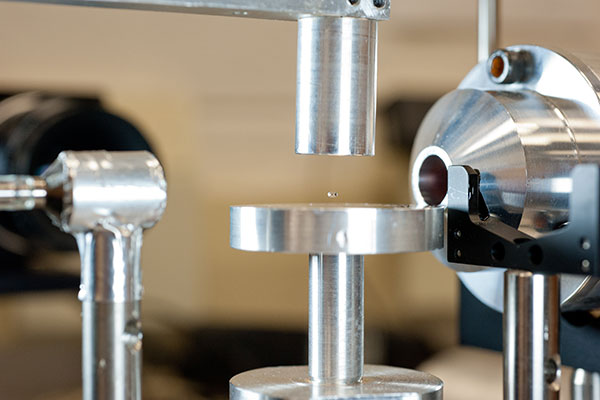
Interfacial Hydrodynamics Research Laboratory
Research themes: In this laboratory, we study any process at an air-water interface. Topics that we have studied include drops, bubbles, water waves, evaporation, and, more recently, gels. Projects have included the levitation of water drops to study their shape, which is critical for the use of radar in the extraction of rain rate and is important to satellite radars such as those used by NASA and NOAA.  We have also investigated how the impact of a water drops (such as a raindrop) does and does not form bubbles, something which is critical to our understanding of how gases such as carbon dioxide are transported across the air/water interface and is critical to understanding how carbon sequestration works on the ocean.
We have also investigated how the impact of a water drops (such as a raindrop) does and does not form bubbles, something which is critical to our understanding of how gases such as carbon dioxide are transported across the air/water interface and is critical to understanding how carbon sequestration works on the ocean.
An important aspect of this lab’s research concerns how particles are removed by drops, such as raindrops in the environment or fog drops in the built environment. Rain cleans the air by removing particles, but exactly how this occurs is still being understood. Fog drops generated using ultrasonic foggers can potentially remove particles from environments such as underground mines, where the fog can clean the air and protect the pulmonary health of miners. In healthcare facilities, this approach has the potential to remove suspended bioaerosols and may protect patients and healthcare workers from infection by viruses that are transmitted via the respiratory route, something which has grown in significance during the Covid-19 pandemic.
Lab facility/equipment: In this laboratory, we use several unique sets of instrumentation to study air/water interfacial processes. A long-term focus has been the study of drops. These experiments are most successful when the drop can be levitated and held stationary. We achieve this using facilities such as a drop levitation tunnel and an ultrasonic drop levitation facility, two pieces of equipment built for this lab.
 A significant part of our activity concerns how drops and particles interact. This work is sensitive to the particle diameter being studied. So we have several particle sizing and counting instruments, such as two Nanoscan SMPS Nanoparticle Sizers (3910) and two MetOne 237A Portable Laser Particle Counters. Also, we often choose to study particle/drop interactions by generating particles with a tightly controlled diameter, and this is done using a vibrating orifice aerosol generator (VOAG) TSI Model 3450.
A significant part of our activity concerns how drops and particles interact. This work is sensitive to the particle diameter being studied. So we have several particle sizing and counting instruments, such as two Nanoscan SMPS Nanoparticle Sizers (3910) and two MetOne 237A Portable Laser Particle Counters. Also, we often choose to study particle/drop interactions by generating particles with a tightly controlled diameter, and this is done using a vibrating orifice aerosol generator (VOAG) TSI Model 3450.
Finally, since drops tend to be small and because their behavior is frequently a function of their shape, we have several high-speed cameras that we use to accurately obtain drop shape as it evolves, including a Canon EOS Rebel T3, a Cooke SensiCam HighSpeed camera, a pco.1200s digital high-speed 10bit CMOS camera, a DSP B/W CCD camera, and an Avenir CCD Monochrome camera.

John Saylor
Lab Director
(864) 656-5621
jsaylor@clemson.edu
